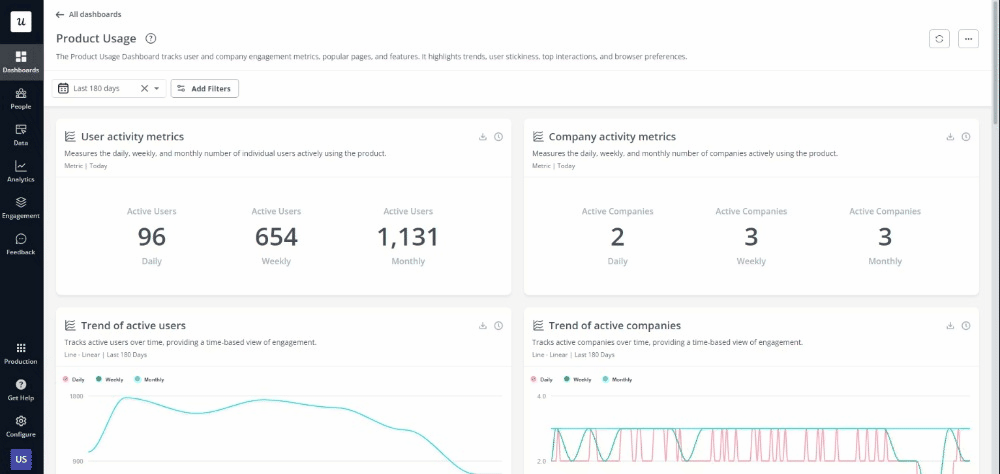
Interested in customer experience analyst roles? You’re in the right place!
In this guide, we’ll explore the ins and outs of customer experience analyst roles through detailed job descriptions and handy templates.
Whether you’re hiring, job hunting, or simply curious, we’ve got you covered with practical insights and ready-to-use resources.
Let’s dive in!
Try Userpilot Now
See Why 1,000+ Teams Choose Userpilot

TL;DR
- A customer experience analyst is a professional who evaluates and improves the interactions between a company and its customers.
- A customer experience analyst job description outlines the essential duties, required skills, and qualifications necessary to deliver actionable insights.
- The specific requirements for this position will vary depending on the company size, industry, and the complexity of the customer journey.
- For instance, a customer experience analyst at a financial services company might focus on improving online banking usability, while one at an ed-tech company might concentrate on enhancing student engagement and learning outcomes.
- Looking into tools for customer experience analysts? Userpilot is an all-in-one product platform with engagement features and powerful analytics capabilities. Book a demo to see it in action!
What is a customer experience analyst?
A customer experience analyst is a professional who evaluates and improves the interactions between a company and its customers.
In the SaaS industry, they analyze customer data, feedback, and behaviors to enhance user satisfaction and retention, ensuring the software meets user needs and expectations.
Customer experience analyst’s main responsibilities
Customer experience analysts play a vital role in ensuring a company’s customers are satisfied and engaged.
Here are the main responsibilities and duties of a customer experience analyst, particularly in the SaaS industry:
- Collect and analyze customer feedback: Gather data from surveys, reviews, and support tickets to identify common issues and areas for improvement.
- Develop customer journey maps: Create visual representations of customer interactions with the product to highlight pain points and opportunities.
- Monitor customer experience metrics: Track key performance indicators such as NPS, CSAT, and churn rate to measure customer satisfaction.
- Collaborate with cross-functional teams: Work with product, marketing, and support teams to implement solutions based on customer insights.
- Conduct usability testing: Test new features and updates to ensure they meet customer needs and expectations.
- Provide actionable insights: Present findings and recommendations to stakeholders to drive product and service improvements.
Customer experience analyst job description and template
Job Description:
[Your Company Name] is seeking a detail-oriented and analytical Customer Experience Analyst to join our team. The ideal candidate will have a passion for understanding customer needs and improving their experience with our SaaS products. You will be responsible for analyzing customer feedback, identifying trends, and collaborating with cross-functional teams to enhance user satisfaction and retention.
Responsibilities:
- Analyze customer feedback and behavior to identify pain points and opportunities for improvement.
- Develop and maintain customer journey maps and personas.
- Collaborate with product, marketing, and support teams to implement customer-centric solutions.
- Monitor and report on key customer experience metrics (e.g., NPS, CSAT).
- Conduct usability testing and provide actionable insights for product improvements.
Requirements:
- Bachelor’s degree in Business, Marketing, Data Science, or a related field.
- Proven experience in customer experience analysis, preferably in the SaaS industry.
- Strong analytical and problem-solving skills.
- Proficiency in data analysis tools (e.g., Excel, SQL, Google Analytics).
- Excellent communication and interpersonal skills.
Best practices to be a great customer experience analyst
Adhering to best practices can significantly enhance your effectiveness as a customer experience analyst. Here are some key practices to follow.
- Understand your customers: Regularly engage with customers to understand their needs and expectations.
- Use data effectively: Leverage data analysis tools to gather insights and make informed decisions.
- Collaborate with teams: Work closely with product, marketing, and support teams to implement customer-centric solutions.
- Stay updated: Keep up with industry trends and best practices in customer experience.
- Be proactive: Anticipate customer needs and address potential issues before they arise.
Customer experience analyst FAQs
Understanding common questions related to the customer experience analyst role can provide additional insights and clarity. Here are some frequently asked questions:
What does a customer experience analyst do?
A customer experience analyst evaluates and improves the interactions between customers and a company’s products or services, often focusing on customer satisfaction, loyalty, and retention.
What skills are needed for a customer experience analyst?
Key skills include analytical abilities, communication skills, customer-centric mindset, technical proficiency, and problem-solving skills.
How much does a customer experience analyst make?
Salaries vary by experience and location, with junior analysts earning $55,000 – $70,000 per year and senior analysts earning $95,000 – $120,000 per year. Location-based salaries also differ, with higher averages in cities like San Francisco and New York.
How can I become a customer experience analyst?
Start with a relevant bachelor’s degree, gain experience through internships or entry-level positions, and develop skills in data analysis and customer journey mapping. Certifications can also enhance qualifications.
What tools do customer experience analysts use?
Common tools include Userpilot for user onboarding, Zendesk for customer support, Google Analytics for website analytics, HubSpot Service Hub for customer service management, and Tableau for data visualization.
Conclusion
We hope this guide has provided you with valuable insights into the roles and responsibilities of customer experience analysts.
By understanding the key responsibilities and skills required, you can make informed decisions and take meaningful steps in your career or recruitment journey.
Looking into tools for customer experience analysts? Userpilot is an all-in-one product platform with engagement features and powerful analytics capabilities. Book a demo to see it in action!








